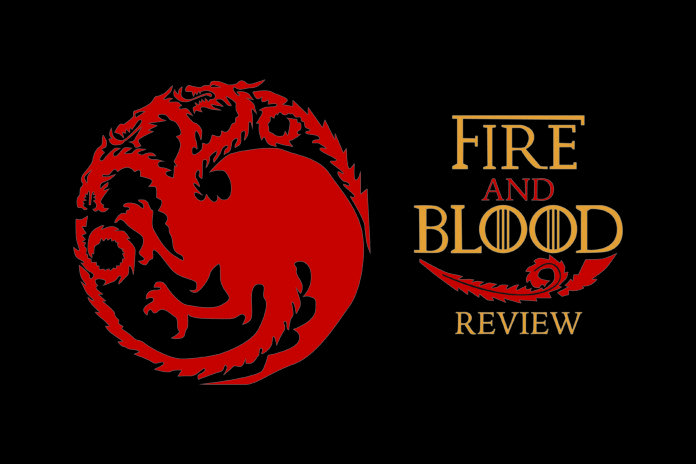George R.R. Martin’s book release wins over the true fans, but not everyone
Despite the many years since George R.R. Martin’s last installment of the “A Song of Fire and Ice” novels was published, the author has blessed his dedicated fans with a text to soften the seven-year interim period they have faced. “Fire and Blood,” the first text in a two-part saga, is a historical account of the Targaryen dynasty amidst their long and bloody reign in the land of Westeros. Beginning with Aegon the Conqueror (ancestor to the widely-known Daenerys Targaryen) and ending with his descendant Aegon III, the Dragonbane, a dark 300-year history unfolds and the reader is free to join ranks in reign of the Targaryen bloodline.
This text is a fictional histographic account inherited and narrated by the in-universe character Archmaester Gyldayn, which is merely being “translated” by Martin, thus straying far from insipid rhetoric one might expect in a history book. The text is focused through the perspective of Gyldayn, which is unreliable at times but nevertheless accurate. Regardless of the detailed accounts he provides on battlefield crusades and red weddings, the Archmaester refuses to answer every question posed by the reader.
The reader gets a taste of the Archmaester’s unreliability in one of the earlier chapters when a Targaryen Queen perishes above the battlefield while astride her dragon. Word reaches home that a “Scorpion bolt” is shot through the dragon’s eye after a period of absence from Queen Rhaenys and her dragon, Meraxes. This tragedy is noted by the Archmaester, but to give an exact account of the detail and omit the mystery is not the way of Gyldayn’s ledger; the reader is not let off that easy.
“Whether Rhaenys Targaryen outlived her dragon remains a matter of dispute,” Martin writes. “Some say that she lost her seat and fell to her death, others that she was crushed beneath Meraxes in the castle yard. A few accounts claim the queen survived her dragon’s fall, only to die a slow death by torment in the dungeons of Ullers.”
This is how most of the tales go in the book, and it is quite brilliant because the reader forms their own conclusions about the history presented, much like the populous of Westeros.
A common phrase of Gyldayn arises more often than not: “It’s been said,” or “Some say.” When the reader is met with these lines, intrigue follows. Gyldayn was not present at every historic event in Westeros. He inherited 300-years worth of detail accounts on the Targaryens.
So who is to say that Aegon Targaryen’s truce with the Kingdom of Dorne was — or was not — brought about by a letter from the Faceless Men? Or, whether or not the king’s guard of Jaehaerys Targaryen stood seven strong against a host of a thousand hostile soldiers? It has been said, it has been rumored, but none have been proven. Therein lies the deepest mysteries of “Fire and Blood.”
Some of the greatest aspects of this novel are the dialogue between characters, which only takes place when an Archmaester is present to observe and record the conversation. And although the reader is neglected much dialogue in their 700 page read, the few conversations they do get turn out to be some of the be the most important parts of the book.
These recorded conversations are important because every character portrayed in the book is a legend of Westeros. Throughout “The Song of Fire and Ice” novels and the “Game of Thrones” television show, the ancient Targaryens (e.g., Aegon the Conqueror, Maegor the Cruel, Jaehaerys the Conciliator, etc) are consistently mentioned. While legends and actions of their reign impact events of the show and novels, the audience is never given a flashback to these characters in the show or book. The 24 chapters of “Fire and Blood” serve as this flashback, filled with countless stories that make us feel at home with these famed characters, something unlike Martin has ever produced before.
Another benefit of the text is being united with the favored kingdoms of Westeros (Starks, Lannisters, Baratheons, etc.) and learning their origins. The reader will not be met with any characters they know from the show or previous novels. Instead they are introduced to iconic ancestors of their favorite houses. For example, Samwell Tarly (ancestor to the modern Samwell Tarly) comes out to play with the dragons in their conquest, and so do the line of Snows. It is obvious that Martin’s intentions were to give his fans a historical background on the whole of the Westeros families; but, whether it be ancestors or descendants, it still pangs the heart when he rips characters from us in a bloody battle or an unexpected assassination.
At times the reading does feel a bit tedious and can get frustrating as there is so much information to register. If a single sentence is misread, there is a chance that it will lead to some confusion down the road. That being said, it is vital to pay close attention to names, relationships, deaths and demises because it all comes into play, one way or another, in the game of thrones.
“Fire and Blood,” will keep impatient fans in an enthralled stasis until “The Winds of Winter” (hopefully) is released in 2019. This latest work from Martin has has been a gift to some and a slap in the face for others since he has been promising “The Winds of Winter,” the sixth installment to “The Song of Fire and Ice” series, for almost a decade now.
Realistically, only die-hard fans will read the book and love every minute of it. But whether it be the fervent fan or the passing reader, “Fire and Blood” provides an inquisitive look into the deep culture of the Seven Kingdoms.
Written By: Clay Allen Rogers — arts@theaggie.org





